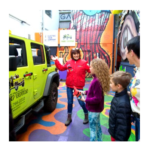CALL US! 1-415-766-2722
Fun@SanFranciscoJeepTours.com
The Transamerica Pyramid: San Francisco’s Architectural Marvel. Rising like a futuristic obelisk in the heart of the Financial District, the Transamerica Pyramid is hard to miss—and that’s exactly the point! It’s one of the most recognizable skyscrapers in the world and a must-see on any San Francisco private tour. Whether you’re a first-time visitor or a local playing tourist, this architectural wonder is best admired up close on a small group sightseeing tour in an open-air Jeep. Let’s take a closer look at the pyramid that put SF’s skyline on the map!
Information provided by: Transamerica Pyramid Center
When unveiled in 1968, the Transamerica Pyramid sparked debate among San Franciscans. Many were skeptical of its obelisk shape, fearing it would disrupt the city’s architectural harmony. However, the pyramid, designed by William Pereira & Associates, quickly became an emblem of San Francisco, as iconic as the Golden Gate Bridge and cable cars. Its construction, starting in 1969 and completed in 1972, marked the birth of a landmark that would symbolize the city’s innovative spirit and resilience.
Rising 853 feet with a distinctive pyramid shape, the Transamerica Pyramid is not just a feat of architectural design but also a marvel of engineering. Its design, featuring a 212-foot decorative aluminum spire, allows for smaller shadows on the city below, showcasing a commitment to environmental sensitivity. The building’s foundation, designed to withstand earthquakes, and its unique window design for easy maintenance, underscore the thoughtful details that make the Transamerica Pyramid a masterpiece of modern architecture.
The Transamerica Pyramid continues to dominate San Francisco’s skyline, a testament to the city’s forward-thinking approach to urban design. While it no longer serves as the headquarters for the Transamerica Corporation, it remains a pivotal piece of the city’s architectural heritage. Its base, Redwood Park, offers a tranquil retreat amidst the bustling Financial District, featuring a grove of redwoods and a fountain that pays homage to Mark Twain.
The Transamerica Pyramid is more than just a building; it’s a symbol of San Francisco’s resilience, innovation, and commitment to environmental stewardship. Its unique design, coupled with the serene Redwood Park, offers visitors a unique blend of architectural marvel and natural beauty. Whether you’re interested in engineering, architecture, or simply looking for iconic sights, the Transamerica Pyramid is a testament to what makes San Francisco unique.
In a city known for its iconic landmarks and cultural heritage, the Transamerica Pyramid stands out as a beacon of architectural ingenuity and environmental consciousness. Its presence on San Francisco’s skyline is a constant reminder of the city’s ability to blend innovation with aesthetic beauty, making it a must-visit destination for travelers and locals alike.
At 853 feet high (260 meters), the Transamerica Pyramid remains one of the tallest buildings in San Francisco. The 48-floor high-rise building is constructed of concrete, glass and steel — and capped with a decorative aluminum 212-foot spire (64.6 meters) rising above the top floor and the “crown jewel” of the building, the beacon at the top.
The 48th Floor serves as an impressive conference room boasting stunning, unobstructed 360-degree views of San Francisco Bay.
The Transamerica Pyramid has 500,000 total square feet of floor space. Its distinctive pyramid shape allows for varied floor plates ranging from the 6th floor, with 22,226 square feet, to the 48th floor, with just 2,531 square feet.
The 9-foot-deep concrete mat foundation, which was continuously poured over a 24-hour period with 1,750 truckloads of concrete, rests on a steel and concrete block, sunk 52 feet (15.5 meters) into the ground, and is designed to move with earth tremors. The Pyramid’s base and foundation is constructed of approximately 16,000 cubic yards of concrete, encasing more than 300 miles of steel reinforcing rods.
The building boasts 3,678 windows. The majority of the windows pivot 360 degrees, which allows them to be cleaned from the inside of the building.
The two “wings,” which flank the building and rise vertically from the 29th floor, are necessary near the top of the Transamerica Pyramid because elevators cannot run at the angle of the building. The eastside wing contains two elevator shafts; the westside wing houses a stairwell and a smoke tower.
In 2007, the Pyramid installed a 1.1-megawatt combined heat and power system, becoming one of only a handful of high-rise buildings in Northern California capable of generating their own electricity. Two 560 kW natural gas-fired reciprocating engine generators are designed to provide approximately 70 percent of the Pyramid’s electrical requirements and 100 percent of its heating and hot water. The cogeneration facility meets three key objectives of the Pyramid’s owners: to strengthen its environmental commitment, deliver annual energy savings and increase the competitiveness of the property in San Francisco’s commercial market.
 Experience San Francisco Like Never Before – Book Your Private Jeep Tour Now!
Experience San Francisco Like Never Before – Book Your Private Jeep Tour Now!See the city’s top sights on your terms with a Private Jeep Tour! Your personal guide takes you to San Francisco’s must-see locations, ensuring unforgettable views and photo stops—including a breathtaking drive across the Golden Gate Bridge.
Don’t just visit—experience San Francisco in style! Spots fill fast—Book your Jeep adventure today!
Privately owned Redwood Park is a unique feature of Transamerica Pyramid Center: An intimate, half-acre redwood grove nestled between the skyscrapers of San Francisco’s Financial District.
Transplanted from the Santa Cruz Mountains 60 miles to the south, magnificent redwoods dominate the park designed by Tom Galli. A fountain designed by Anthony Guzzardo — its pond complete with jumping frog sculptures, in a fond remembrance of Mark Twain, who for a time lived and wrote on this site — lends the sound of running water to those who seek peaceful moments here. Ferns, boulders and a winding walkway add to the tranquility.
Also featured in the park are a Glenna Goodacre bronze sculpture of children at play, a bronze plaque honoring two dogs that legend would have it were Emperor Norton’s canine sidekicks, and benches and tables for business people and visitors taking a respite.
In addition to being a stylistic statement, the Transamerica Pyramid’s unconventional silhouette is also the result of environmentally sensitive planning. The tapered design casts a smaller shadow and therefore allows more natural light to filter down to the streets below than its conventional high-rise neighbors — important in a city where the sun has to do almost daily battle with the fog.
In designing the building, architects William Pereira & Associates also adhered to San Francisco’s unique shadow restriction legislation, which imposes a certain ratio between buildings’ surfaces and their heights.
The 6,000-watt beacon, envisioned by the architect as the building’s “crown jewel,” can be seen from all over the San Francisco Bay Area at night when lit on special occasions.
The aircraft light — a red flashing light at the top of the spire — is a 1,000-watt high-voltage neon lamp required by the FAA.
No. All of the Pyramid’s interior lights are motion-activated for energy conservation, and as a result, the building’s lights are only lit during business hours.
For security reasons, the Pyramid is not open to the public.
In a seismically active region, it is important to engineer buildings, especially skyscrapers, to withstand tremors. San Francisco is very close to the San Andreas and Hayward Faults — in fact, in 1989, the 6.9-magnitude Loma Prieta earthquake struck the Santa Cruz Mountains about 60 miles away. Although the 48-story-high Pyramid shook for more than a minute, during which the top story swayed almost a foot from side to side, the building was undamaged.
Such success can be attributed to the building’s careful structural engineering. In addition to its 52-foot-deep steel and concrete foundation, which is designed to move with earthquakes, the Transamerica Pyramid’s exterior is covered with white precast quartz aggregate, interlaced with reinforcing rods at four places on each floor. Clearance between the panels allows lateral movement in the event of an earthquake. In addition, a unique truss system above the first floor supports both vertical and horizontal loading, and interior frames extend up to the 45th floor.
As a result of all these measures, the building resists torsional movement and is engineered to take large horizontal base shear forces.
Whether you’re admiring it from a nearby park, snapping skyline selfies, or learning its story from your Jeep tour guide, the Transamerica Pyramid is one landmark you won’t forget. It’s not just a building—it’s a symbol of San Francisco’s bold, innovative spirit. And there’s no better way to experience it than from the open-air seat of a private San Francisco sightseeing tour.
Ready to explore SF from top to bottom (including the top of the skyline)?
Book your San Francisco Jeep Tour today and let’s roll past the city’s most unforgettable sights—pyramid included!
The Transamerica Pyramid is a registered trademark of Transamerica Corporation. Information provided by: Transamerica Pyramid Center
Text box item sample content
